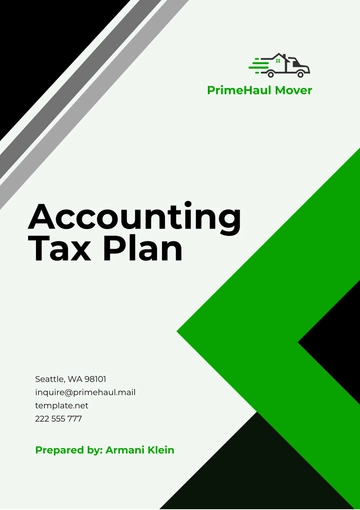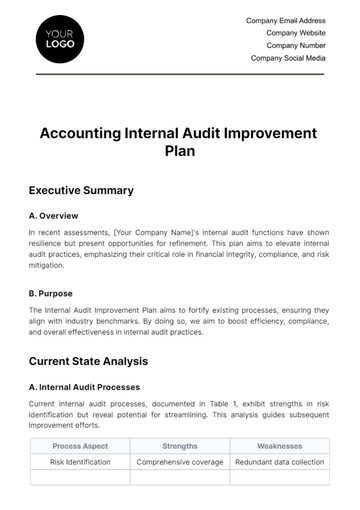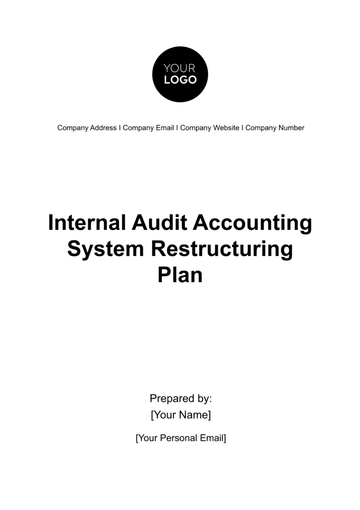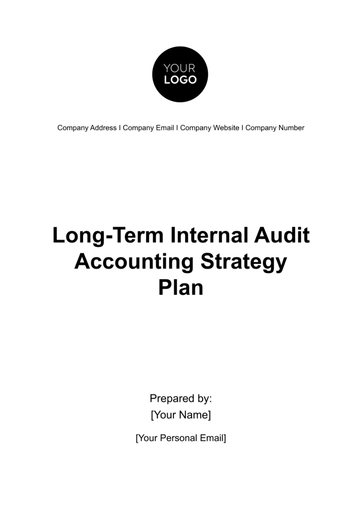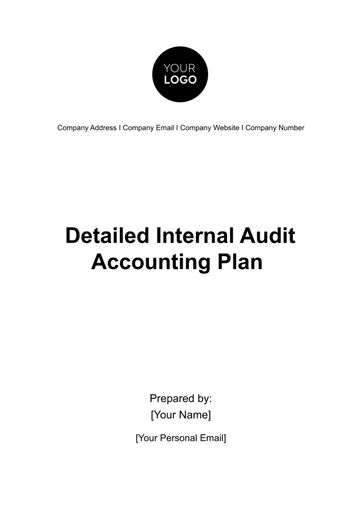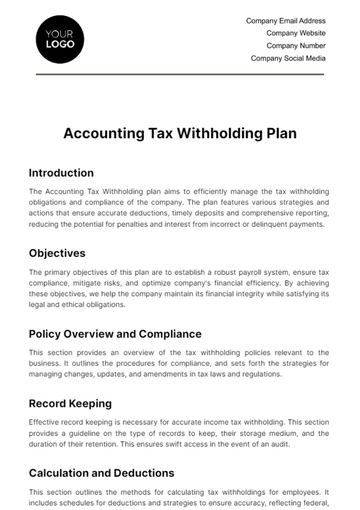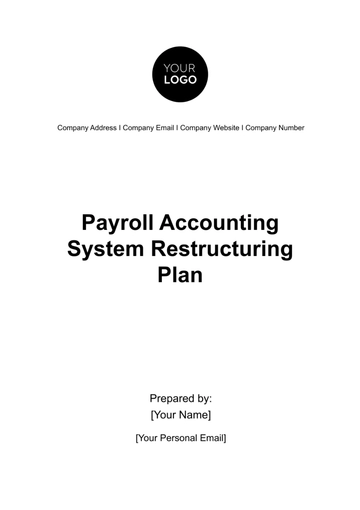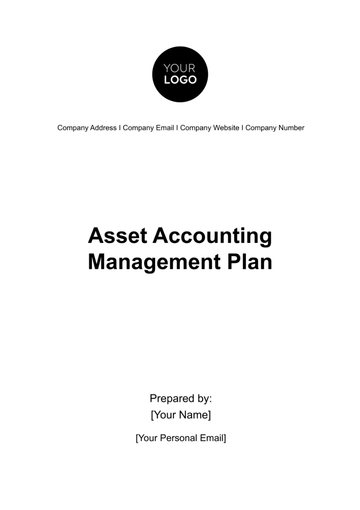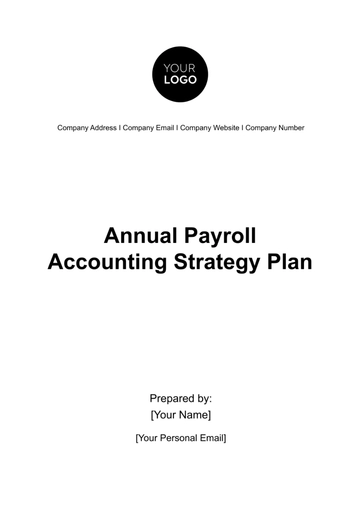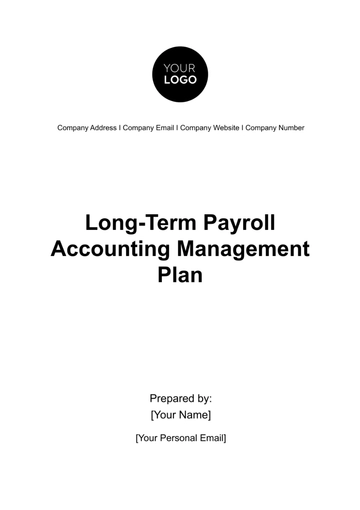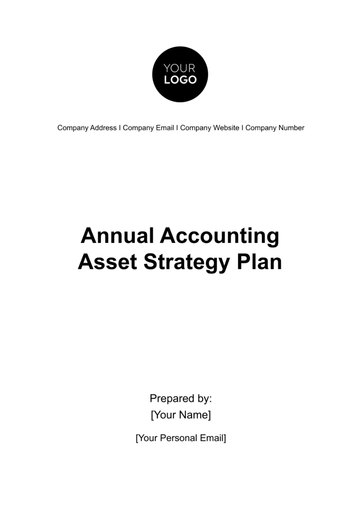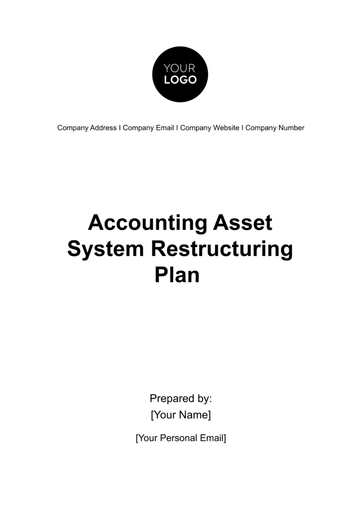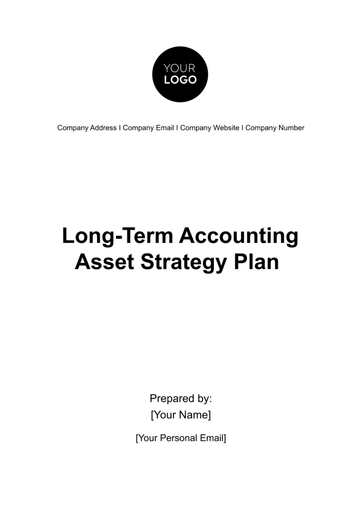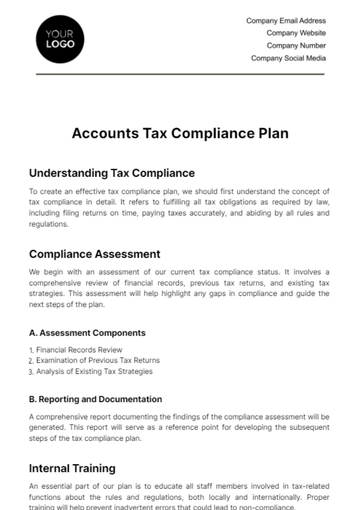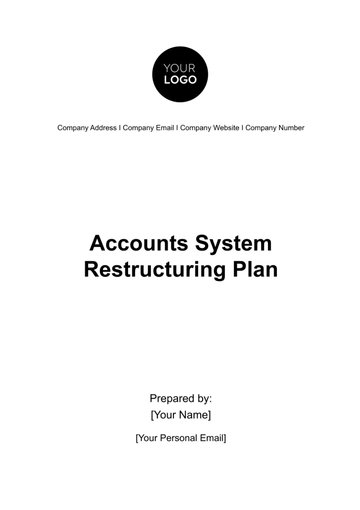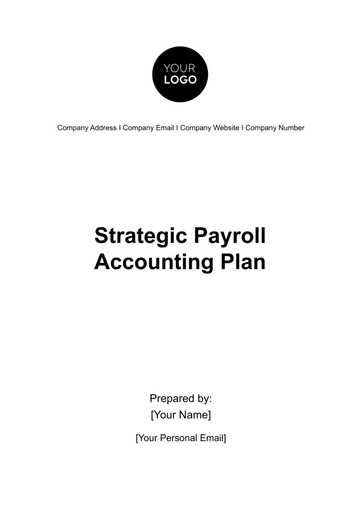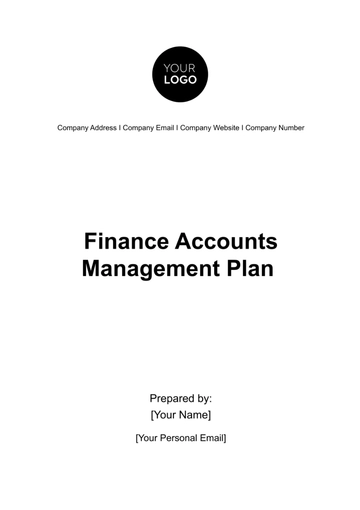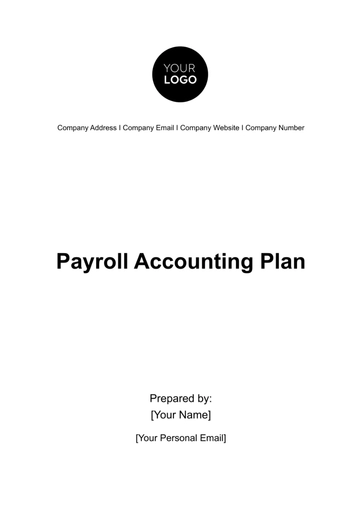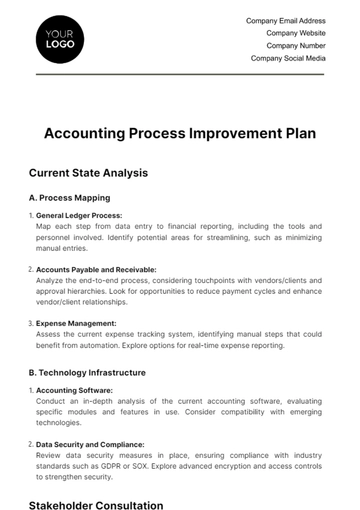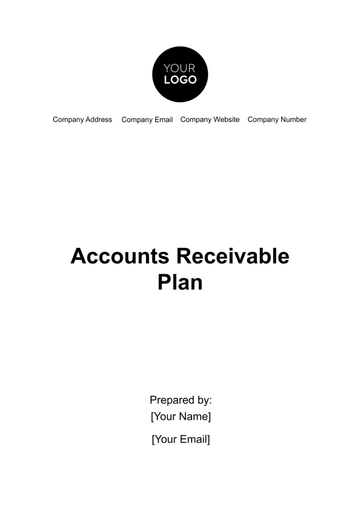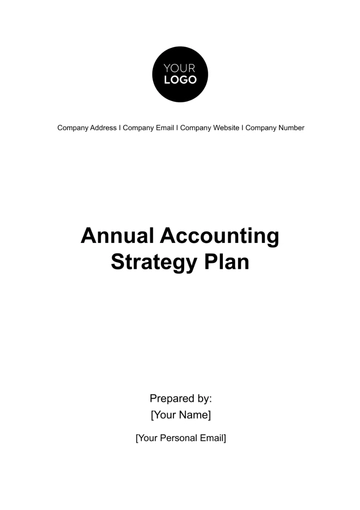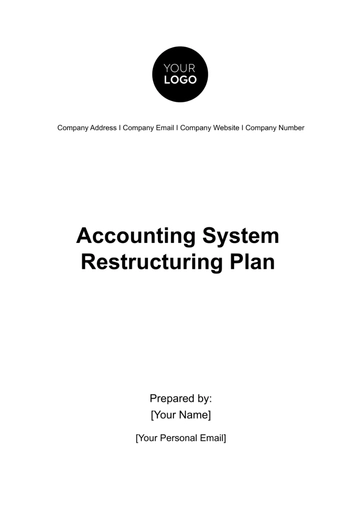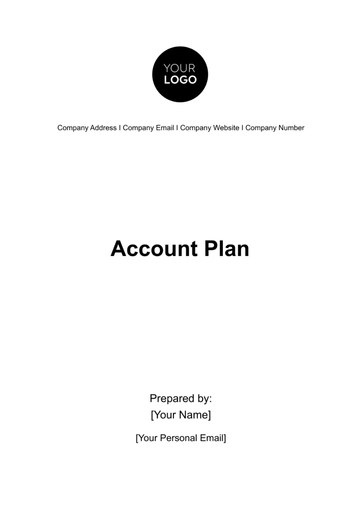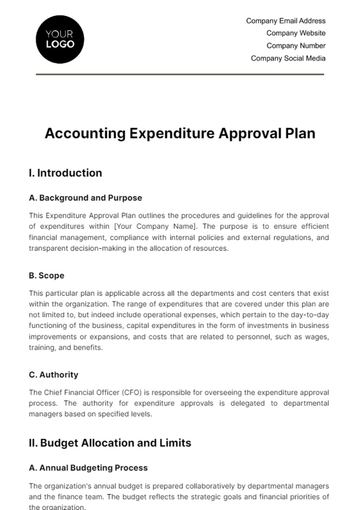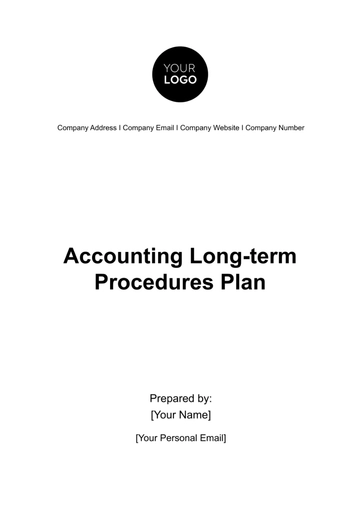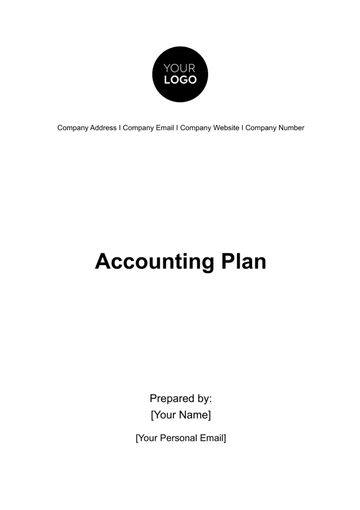Free Annual Accounting Asset Strategy Plan
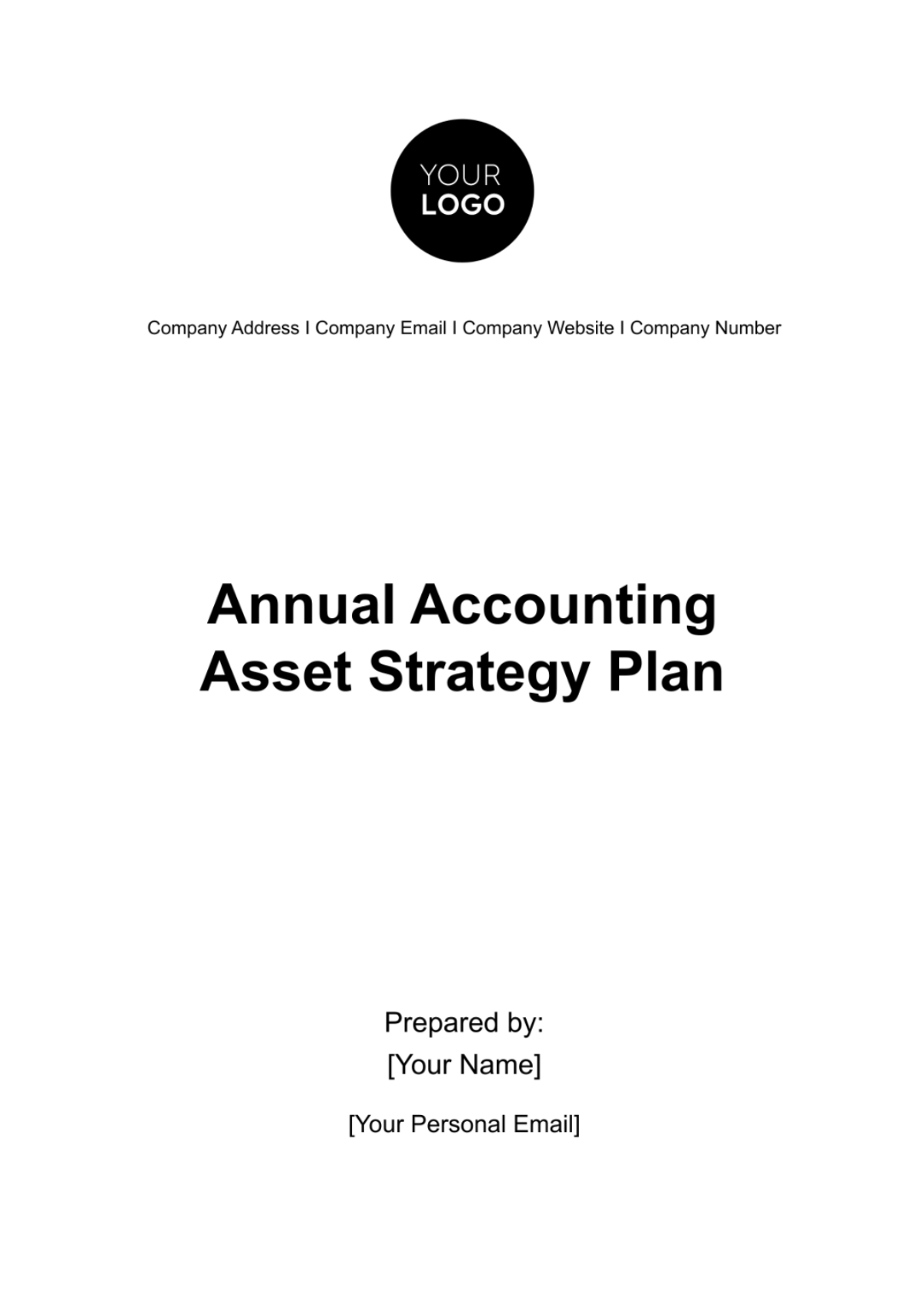
Executive Summary
This Annual Accounting Asset Strategy Plan has been crafted to bolster our corporation's financial robustness, guarantee adherence to regulatory frameworks, and augment profitability margins. The strategic blueprint delineated herein endeavors to harmonize growth ambitions with sustainability and profitability objectives. This will be achieved through the implementation of judicious cost management practices, optimization of resources, meticulous risk management, and stringent compliance protocols.
Objectives
The objectives of this strategic initiative are meticulously defined to ensure a comprehensive approach towards the management and enhancement of [Your Company Name]'s assets. They are as follows:
Strategic Direction and Asset Management: Our goal is to establish a coherent strategic framework for the effective governance and meticulous oversight of [Your Company Name]'s assets. This framework aims to maximize asset value and optimize their use, ensuring that every asset contributes to our overarching goals of growth and sustainability.
Financial Reporting Accuracy and Timeliness: We are committed to ensuring the accuracy and timeliness of our financial reports. This commitment is crucial for maintaining transparency and fostering trust with our stakeholders, thereby reinforcing our reputation for reliability and integrity in financial reporting.
Cost Efficiency Enhancement: Our strategy includes a proactive approach to identifying and leveraging opportunities to reduce operational costs. By doing so, we aim to enhance the company's financial performance and efficiency, ensuring a more robust bottom line.
Internal Controls Strengthening: Strengthening internal controls is paramount to our strategy. We aim to bolster our internal governance mechanisms to safeguard against errors, fraud, and inefficiencies. This will enhance the reliability of our asset management and financial reporting processes, ensuring they are secure and effective.
Compliance with Accounting Standards and Regulations: Adherence to accounting standards and regulatory requirements is non-negotiable. We aim to maintain rigorous compliance to mitigate legal and financial risks, thereby protecting our company from potential compliance-related repercussions.
Underpinning these objectives is our unwavering commitment to strategic foresight, operational excellence, and strict regulatory compliance. This foundation ensures that [Your Company Name] continues to lead with financial integrity and accountability, setting a benchmark in asset management and financial stewardship.
Asset Evaluation
The cornerstone of our strategy is predicated upon an annual, in-depth assessment of our assets. This critical exercise encompasses a holistic valuation of both tangible and intangible assets, meticulous analysis of their respective lifespans, and a thorough examination of their contributions to the overall value proposition of [Your Company Name]. By engaging in this rigorous evaluation process, we aim to achieve several key objectives:
Accuracy in Financial Reporting: Through the detailed assessment of our assets, we ensure that our financial records accurately reflect the current value and condition of our assets. This accuracy is paramount for maintaining integrity in our financial statements and fostering trust among investors, regulators, and other stakeholders.
Strategic Asset Management: The insights gained from the asset evaluation enable us to make informed decisions regarding asset maintenance, enhancement, and potential divestiture. By understanding the real value and utility of each asset, we can strategize on optimizing their use, extending their useful life, or disposing of underperforming assets in a timely manner.
Risk Management: Evaluating our assets on an annual basis also plays a crucial role in identifying and mitigating risks associated with asset depreciation, obsolescence, or impairment. This proactive approach to risk management supports the financial stability and sustainability of our business.
Supporting Strategic Decisions: The comprehensive understanding of our asset base aids in the formulation of strategic business decisions. Whether it's expanding into new markets, investing in research and development, or adjusting our business model, the asset evaluation provides a solid foundation for making decisions that align with our long-term objectives.
Key Components for Asset Evaluation:
Aspect | Description |
|---|---|
Valuation | Comprehensive appraisal of tangible and intangible assets to determine their current market value. |
The annual evaluation of our assets is not merely a procedural necessity; it is a strategic imperative that enhances our financial accuracy, facilitates strategic asset management, mitigates risks, and supports informed decision-making. This process ensures that [Your Company Name] remains agile, competitive, and financially robust in a competitive business market.
Budget Setting & Control
The establishment of a robust budget setting and control mechanism is pivotal in our strategic financial management framework. This mechanism is designed to ensure agility and precision in our financial operations, enabling prompt and effective responses to unforeseen financial circumstances. Our approach encompasses three fundamental phases: budget formulation, real-time tracking, and active management of budget deviations.
Phase | Description |
|---|---|
Budget Formulation | The process begins with the meticulous setting of budgets, which involves defining financial targets based on strategic objectives, historical data, and forecasted projections. |
Through the integration of these phases, our budget setting and control framework aims to achieve the following objectives:
Enhanced Financial Discipline: By setting clear budgetary boundaries and continuously monitoring financial performance, we instill a culture of financial discipline and accountability.
Increased Operational Agility: The ability to respond swiftly to financial variances empowers us to adapt to changing market conditions, safeguarding our financial health and strategic objectives.
Strategic Decision Support: Real-time financial insights facilitate informed decision-making, allowing us to allocate resources more effectively and pursue opportunities with the highest potential for return.
Risk Mitigation: Proactive management of budget deviations helps in identifying and mitigating financial risks before they escalate, ensuring financial stability.
Our budget setting and control mechanism is not merely a financial tool, but a strategic asset that underpins our ability to navigate uncertainty, optimize financial performance, and drive sustainable growth. This comprehensive approach ensures that [Your Company Name] remains resilient, competitive, and financially sound in an unpredictable business environment.
Compliance Management
The essence of our strategic agenda is a robust Compliance Management framework, aimed at ensuring adherence to legal mandates, regulatory filings, and established accounting standards such as GAAP (Generally Accepted Accounting Principles) and IFRS (International Financial Reporting Standards). This central goal is pivotal to maintaining our company's integrity, reputation, and operational excellence. Our strategy for achieving and maintaining compliance encompasses a multifaceted approach:
Continuous Knowledge Update: Recognizing the fluidity of legal and regulatory landscapes, we commit to keeping our knowledge base current. This involves monitoring developments in laws, regulations, and accounting standards, ensuring that our practices remain aligned with the latest requirements.
Team Training and Development: A key component of our compliance strategy is the ongoing education and development of our accounting team. By providing regular training sessions and resources, we aim to equip our staff with the necessary tools and insights to navigate the complexities of financial reporting and compliance.
Regular Audits and Reviews: To reinforce our compliance framework, we will conduct regular internal audits and compliance reviews. These assessments are designed to identify any deviations from required standards and implement corrective measures promptly. This proactive audit process aids in mitigating risks and enhancing the overall reliability of our financial reporting.
Stakeholder Engagement: Engaging with stakeholders, including regulatory bodies, auditors, and legal advisors, is crucial. This engagement ensures that our compliance efforts are not only reactive but also anticipatory, preparing us for forthcoming changes and advising on best practices.
Technology Utilization: Leveraging technology to streamline compliance processes is another cornerstone of our approach. By employing advanced software and tools, we can automate compliance tracking, enhance accuracy in reporting, and facilitate a more efficient audit process.
Our Compliance Management strategy is built on a foundation of continuous learning, rigorous internal controls, and proactive engagement with regulatory trends and changes. Through this comprehensive approach, [Your Company Name] is dedicated to upholding the highest standards of compliance, thereby safeguarding our operational integrity and contributing to our long-term success.
Internal Controls
The fortification of Internal Controls stands as a cornerstone within our strategic framework, designed to establish a formidable defense against fraud, facilitate the detection of errors, and ensure comprehensive financial oversight. Recognizing the critical role that effective internal controls play in safeguarding assets and enhancing the reliability of financial reporting, our commitment is to systematically strengthen these structures. Our strategy for bolstering internal controls encompasses several key initiatives:
Segregation of Duties: Central to our approach is the strategic segregation of duties, which is fundamental in reducing the risk of errors and fraudulent activities. By clearly delineating responsibilities among different individuals or departments, we ensure that no single entity has control over all aspects of any financial transaction, thereby enhancing checks and balances within our processes.
Technology Implementation: Leveraging advanced technology and financial management systems is another pillar of our strategy. The deployment of sophisticated software solutions will automate key financial processes, improve accuracy, and provide real-time reporting capabilities. This technological enhancement not only streamlines operations but also introduces a higher level of precision in our financial management practices.
Regular Checks and Audits: To complement these measures, we will institute a regimen of regular checks and audits. These periodic reviews will be conducted internally and, where necessary, externally, to assess the effectiveness of our internal controls and identify areas for improvement. Through these audits, we aim to promptly address any vulnerabilities and ensure compliance with relevant financial regulations and standards.
Continuous Improvement and Training: Recognizing that the financial landscape and associated risks are ever-evolving, we commit to a culture of continuous improvement. This includes regular training and development opportunities for our staff, ensuring they remain abreast of best practices in risk management and internal control procedures. By fostering a culture of learning and vigilance, we empower our employees to contribute effectively to our internal control framework.
Stakeholder Communication: Effective communication with stakeholders regarding our internal control environment and changes thereto is essential. This openness not only builds trust but also encourages feedback, which can be invaluable in refining our control mechanisms.
Our strategic emphasis on Internal Controls is a testament to our dedication to financial integrity, operational efficiency, and risk mitigation. By advancing our internal control structures through the segregation of duties, embracing technology, conducting regular audits, promoting continuous improvement, and maintaining transparent communication, [Your Company Name] is poised to achieve not only regulatory compliance but also operational excellence.
Risk Management
The strategic blueprint of [Your Company Name] places a paramount emphasis on the implementation of an advanced Risk Management framework. This initiative is vital for the safeguarding of our assets and the sustainable success of our enterprise. Our Risk Management strategy is built upon a multi-faceted approach that includes the following key components:
Risk Identification: The first step in our risk management process involves the systematic identification of potential risks that could impact our financial health and operational stability. This includes, but is not limited to, credit risk, market risk, liquidity risk, and operational risk. Utilizing both quantitative and qualitative analysis methods, we aim to recognize these risks at an early stage.
Risk Assessment: Following identification, each risk is thoroughly evaluated to determine its potential magnitude and the likelihood of occurrence. This assessment is crucial for prioritizing risks based on their potential impact on [Your Company Name], enabling us to allocate our resources more efficiently and effectively.
Risk Mitigation Strategies: With a clear understanding of the prioritized risks, we will develop and implement targeted risk mitigation strategies. These strategies may include diversification of assets to mitigate market risk, enhancing credit analysis procedures to reduce credit risk, implementing advanced cybersecurity measures to address operational risks related to information security, and establishing robust contingency plans for critical operations.
Continuous Monitoring and Review: Recognizing that the risk landscape is constantly evolving, our risk management approach includes ongoing monitoring and review of risk factors and the effectiveness of mitigation strategies. This dynamic process allows us to adapt and refine our risk management practices in response to internal and external changes.
Stakeholder Engagement: Effective risk management also involves clear and transparent communication with all stakeholders, including employees, investors, and regulators. By keeping these parties informed about our risk management practices and developments, we foster a culture of trust and collective responsibility towards managing risks.
Integration with Strategic Planning: Our risk management efforts are intricately linked with our overall strategic planning process. By integrating risk considerations into our strategic decisions, we ensure that risk management is not a standalone activity but a fundamental aspect of our corporate governance and strategic direction.
Liquidity Risk: The potential for our company to encounter difficulties in meeting obligations due to the inability to liquidate assets quickly or obtain funding. Our strategy includes maintaining adequate levels of liquid assets and access to reliable funding sources.
Compliance Risk: The risk of legal or regulatory sanctions, financial loss, or damage to reputation our company might face as a result of failure to comply with laws, regulations, codes of conduct, and standards of good practice. To mitigate this risk, we will ensure continuous monitoring and updating of compliance protocols in line with evolving regulations.
Strategic Risk: Arising from adverse business decisions, or the failure to implement appropriate business decisions in a manner that aligns with our strategic goals. Mitigation involves thorough strategic planning, regular review of business decisions, and ensuring flexibility in strategy to adapt to market changes.
Reputational Risk: The risk of loss resulting from damages to a firm's reputation, in turn affecting its business and financial standing. This will be managed through maintaining high standards of customer service, ethical conduct, and transparent communication.
The Risk Management strategy of [Your Company Name] is designed to provide a comprehensive shield against financial risks, ensuring the long-term stability and growth of our organization. Through diligent risk identification, assessment, and mitigation, along with continuous monitoring and stakeholder engagement, we are committed to maintaining a robust risk management framework that supports our strategic objectives and enhances shareholder value.
Long-term Strategic Planning
In the culmination of our strategic efforts, the plan will be seamlessly integrated into [Your Company Name]'s overarching long-term strategic planning framework. This integration signifies our commitment to leveraging the comprehensive insights gained from meticulous asset management as a cornerstone for informed forecasting, robust growth planning, and the assurance of our company's sustainability over the foreseeable future. The schedule for our long-term strategic planning process is outlined in the table below, ensuring a structured and continuous approach to achieving our long-term objectives:
Phase | Activity | Timeline |
|---|---|---|
Insight Gathering | Compilation of data from asset management and market research. | [Date] - [Date] |
This structured approach ensures that [Your Company Name] remains aligned with its long-term vision, while also maintaining the flexibility to adapt to unforeseen changes in the business environment. Our strategic planning process is underpinned by a commitment to thorough analysis, proactive decision-making, and continuous improvement. By aligning our asset management insights with our long-term planning, we aim to not only forecast future developments but also to shape them, positioning [Your Company Name] for sustained growth and success.
Our long-term strategic planning is not just about predicting the future but actively participating in its creation. This involves a continuous cycle of setting strategic directions, executing plans, monitoring results, and making the necessary adjustments to ensure that [Your Company Name] not only survives but thrives in the long run. Through this comprehensive and dynamic approach, we are dedicated to securing the company's position as a leader in our industry, ensuring its profitability, sustainability, and growth for years to come.
- 100% Customizable, free editor
- Access 1 Million+ Templates, photo’s & graphics
- Download or share as a template
- Click and replace photos, graphics, text, backgrounds
- Resize, crop, AI write & more
- Access advanced editor
Elevate your financial planning with Template.net's Annual Accounting Asset Strategy Plan Template. Crafted for strategic foresight, this template is fully editable and customizable, allowing for a tailored approach to your annual asset management. The flexibility of modification in our Ai Editor Tool ensures that finance professionals can align the template with their strategic goals seamlessly.
You may also like
- Finance Plan
- Construction Plan
- Sales Plan
- Development Plan
- Career Plan
- Budget Plan
- HR Plan
- Education Plan
- Transition Plan
- Work Plan
- Training Plan
- Communication Plan
- Operation Plan
- Health And Safety Plan
- Strategy Plan
- Professional Development Plan
- Advertising Plan
- Risk Management Plan
- Restaurant Plan
- School Plan
- Nursing Home Patient Care Plan
- Nursing Care Plan
- Plan Event
- Startup Plan
- Social Media Plan
- Staffing Plan
- Annual Plan
- Content Plan
- Payment Plan
- Implementation Plan
- Hotel Plan
- Workout Plan
- Accounting Plan
- Campaign Plan
- Essay Plan
- 30 60 90 Day Plan
- Research Plan
- Recruitment Plan
- 90 Day Plan
- Quarterly Plan
- Emergency Plan
- 5 Year Plan
- Gym Plan
- Personal Plan
- IT and Software Plan
- Treatment Plan
- Real Estate Plan
- Law Firm Plan
- Healthcare Plan
- Improvement Plan
- Media Plan
- 5 Year Business Plan
- Learning Plan
- Marketing Campaign Plan
- Travel Agency Plan
- Cleaning Services Plan
- Interior Design Plan
- Performance Plan
- PR Plan
- Birth Plan
- Life Plan
- SEO Plan
- Disaster Recovery Plan
- Continuity Plan
- Launch Plan
- Legal Plan
- Behavior Plan
- Performance Improvement Plan
- Salon Plan
- Security Plan
- Security Management Plan
- Employee Development Plan
- Quality Plan
- Service Improvement Plan
- Growth Plan
- Incident Response Plan
- Basketball Plan
- Emergency Action Plan
- Product Launch Plan
- Spa Plan
- Employee Training Plan
- Data Analysis Plan
- Employee Action Plan
- Territory Plan
- Audit Plan
- Classroom Plan
- Activity Plan
- Parenting Plan
- Care Plan
- Project Execution Plan
- Exercise Plan
- Internship Plan
- Software Development Plan
- Continuous Improvement Plan
- Leave Plan
- 90 Day Sales Plan
- Advertising Agency Plan
- Employee Transition Plan
- Smart Action Plan
- Workplace Safety Plan
- Behavior Change Plan
- Contingency Plan
- Continuity of Operations Plan
- Health Plan
- Quality Control Plan
- Self Plan
- Sports Development Plan
- Change Management Plan
- Ecommerce Plan
- Personal Financial Plan
- Process Improvement Plan
- 30-60-90 Day Sales Plan
- Crisis Management Plan
- Engagement Plan
- Execution Plan
- Pandemic Plan
- Quality Assurance Plan
- Service Continuity Plan
- Agile Project Plan
- Fundraising Plan
- Job Transition Plan
- Asset Maintenance Plan
- Maintenance Plan
- Software Test Plan
- Staff Training and Development Plan
- 3 Year Plan
- Brand Activation Plan
- Release Plan
- Resource Plan
- Risk Mitigation Plan
- Teacher Plan
- 30 60 90 Day Plan for New Manager
- Food Safety Plan
- Food Truck Plan
- Hiring Plan
- Quality Management Plan
- Wellness Plan
- Behavior Intervention Plan
- Bonus Plan
- Investment Plan
- Maternity Leave Plan
- Pandemic Response Plan
- Succession Planning
- Coaching Plan
- Configuration Management Plan
- Remote Work Plan
- Self Care Plan
- Teaching Plan
- 100-Day Plan
- HACCP Plan
- Student Plan
- Sustainability Plan
- 30 60 90 Day Plan for Interview
- Access Plan
- Site Specific Safety Plan
